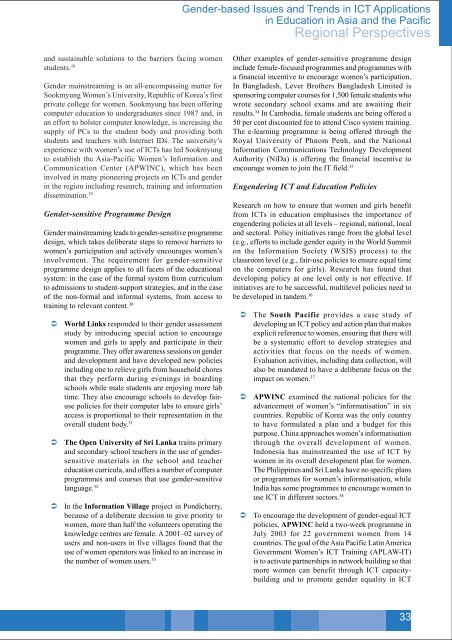Download (PDF, 2.MB) - UNESCO Bangkok
Download (PDF, 2.MB) - UNESCO Bangkok
Download (PDF, 2.MB) - UNESCO Bangkok
- No tags were found...
Create successful ePaper yourself
Turn your PDF publications into a flip-book with our unique Google optimized e-Paper software.
Gender-based Issues and Trends in ICT Applicationsin Education in Asia and the PacificRegional Perspectivesand sustainable solutions to the barriers facing womenstudents. 28Gender mainstreaming is an all-encompassing matter forSookmyung Women’s University, Republic of Korea’s firstprivate college for women. Sookmyung has been offeringcomputer education to undergraduates since 1987 and, inan effort to bolster computer knowledge, is increasing thesupply of PCs to the student body and providing bothstudents and teachers with Internet IDs. The university’sexperience with women’s use of ICTs has led Sookmyungto establish the Asia-Pacific Women’s Information andCommunication Center (APWINC), which has beeninvolved in many pioneering projects on ICTs and genderin the region including research, training and informationdissemination. 29Gender-sensitive Programme DesignGender mainstreaming leads to gender-sensitive programmedesign, which takes deliberate steps to remove barriers towomen’s participation and actively encourages women’sinvolvement. The requirement for gender-sensitiveprogramme design applies to all facets of the educationalsystem: in the case of the formal system from curriculumto admissions to student-support strategies, and in the caseof the non-formal and informal systems, from access totraining to relevant content. 30World Links responded to their gender assessmentstudy by introducing special action to encouragewomen and girls to apply and participate in theirprogramme. They offer awareness sessions on genderand development and have developed new policiesincluding one to relieve girls from household choresthat they perform during evenings in boardingschools while male students are enjoying more labtime. They also encourage schools to develop fairusepolicies for their computer labs to ensure girls’access is proportional to their representation in theoverall student body. 31The Open University of Sri Lanka trains primaryand secondary school teachers in the use of gendersensitivematerials in the school and teachereducation curricula, and offers a number of computerprogrammes and courses that use gender-sensitivelanguage. 32In the Information Village project in Pondicherry,because of a deliberate decision to give priority towomen, more than half the volunteers operating theknowledge centres are female. A 2001–02 survey ofusers and non-users in five villages found that theuse of women operators was linked to an increase inthe number of women users. 33Other examples of gender-sensitive programme designinclude female-focused programmes and programmes witha financial incentive to encourage women’s participation.In Bangladesh, Lever Brothers Bangladesh Limited issponsoring computer courses for 1,500 female students whowrote secondary school exams and are awaiting theirresults. 34 In Cambodia, female students are being offered a50 per cent discounted fee to attend Cisco system training.The e-learning programme is being offered through theRoyal University of Phnom Penh, and the NationalInformation Communications Technology DevelopmentAuthority (NiDa) is offering the financial incentive toencourage women to join the IT field. 35Engendering ICT and Education PoliciesResearch on how to ensure that women and girls benefitfrom ICTs in education emphasises the importance ofengendering policies at all levels – regional, national, localand sectoral. Policy initiatives range from the global level(e.g., efforts to include gender equity in the World Summiton the Information Society (WSIS) process) to theclassroom level (e.g., fair-use policies to ensure equal timeon the computers for girls). Research has found thatdeveloping policy at one level only is not effective. Ifinitiatives are to be successful, multilevel policies need tobe developed in tandem. 36The South Pacific provides a case study ofdeveloping an ICT policy and action plan that makesexplicit reference to women, ensuring that there willbe a systematic effort to develop strategies andactivities that focus on the needs of women.Evaluation activities, including data collection, willalso be mandated to have a deliberate focus on theimpact on women. 37APWINC examined the national policies for theadvancement of women’s “informatisation” in sixcountries. Republic of Korea was the only countryto have formulated a plan and a budget for thispurpose. China approaches women’s informatisationthrough the overall development of women.Indonesia has mainstreamed the use of ICT bywomen in its overall development plan for women.The Philippines and Sri Lanka have no specific plansor programmes for women’s informatisation, whileIndia has some programmes to encourage women touse ICT in different sectors. 38To encourage the development of gender-equal ICTpolicies, APWINC held a two-week programme inJuly 2003 for 22 government women from 14countries. The goal of the Asia Pacific Latin AmericaGovernment Women’s ICT Training (APLAW-IT)is to activate partnerships in network building so thatmore women can benefit through ICT capacitybuildingand to promote gender equality in ICT33
















